
Savannah is the oldest city in the U.S. state of Georgia and is the county seat of Chatham County. Established in 1733 on the Savannah River, the city of Savannah became the British colonial capital of the Province of Georgia and later the first state capital of Georgia. A strategic port city in the American Revolution and during the American Civil War, Savannah is today an industrial center and an important Atlantic seaport. It is Georgia's fifth-largest city, with a 2020 U.S. Census population of 147,780. The Savannah metropolitan area, Georgia's third-largest, had a 2020 population of 404,798.
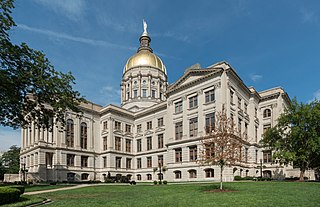
The Georgia State Capitol is an architecturally and historically significant building in Atlanta, Georgia, United States. The building has been named a National Historic Landmark which is listed on the National Register of Historic Places. As the primary office building of Georgia's government, the capitol houses the offices of the governor, lieutenant governor, and secretary of state on the second floor, chambers in which the General Assembly, consisting of the Georgia State Senate and Georgia House of Representatives, meets annually from January to April. The fourth floor houses visitors' galleries overlooking the legislative chambers and a museum located near the rotunda in which a statue of Miss Freedom caps the dome.
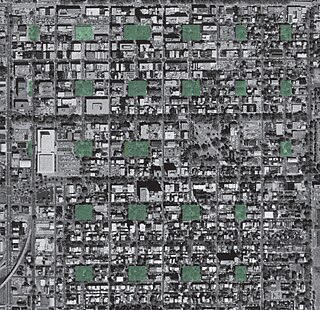
The city of Savannah, Province of Georgia, was laid out in 1733, in what was colonial America, around four open squares, each surrounded by four residential ("tything") blocks and four civic ("trust") blocks. The layout of a square and eight surrounding blocks was known as a "ward." The original plan was part of a larger regional plan that included gardens, farms, and "out-lying villages." Once the four wards were developed in the mid-1730s, two additional wards were laid. Oglethorpe's agrarian balance was abandoned after the Georgia Trustee period. Additional squares were added during the late 18th and 19th centuries, and by 1851 there were 24 squares in the city. In the 20th century, three of the squares were demolished or altered beyond recognition, leaving 21. In 2010, one of the three "lost" squares, Ellis, was reclaimed, bringing the total to today's 22.

The Jekyll Island Club was a private club on Jekyll Island, on Georgia's Atlantic coast. It was founded in 1886 when members of an incorporated hunting and recreational club purchased the island for $125,000 from John Eugene du Bignon. The original design of the Jekyll Island Clubhouse, with its signature turret, was completed in January 1888. The club thrived through the early 20th century; its members came from many of the world's wealthiest families, most notably the Morgans, Rockefellers, and Vanderbilts. The club closed at the end of the 1942 season due to complications from World War II. In 1947, after five years of funding a staff to keep up the lawn and cottages, the island was purchased from the club's remaining members for $675,000 during condemnation proceedings by the state of Georgia.

The Green–Meldrim House is a historic house at 14 West Macon Street, on the northwest corner of Madison Square, in Savannah, Georgia. Built in 1853, it was designated as a National Historic Landmark in 1976 as one of the American South's finest and most lavish examples of Gothic Revival architecture. The house is owned by the adjacent St. John's Episcopal Church, which offers tours and uses it as a meeting and reception space.

The Owens–Thomas House & Slave Quarters is a historic home in Savannah, Georgia, that is operated as a historic house museum by Telfair Museums. It is located at 124 Abercorn Street, on the northeast corner of Oglethorpe Square. The Owens–Thomas House was designated a National Historic Landmark in 1976, as one of the nation's finest examples of English Regency architecture.
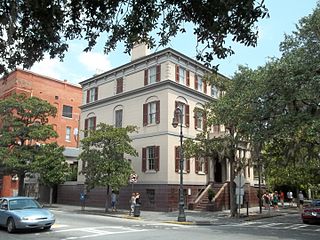
Juliette Gordon Low Historic District consists of three buildings—the Juliette Gordon Low Birthplace (also known as Wayne-Gordon House, First Girl Scout Headquarters, which was the carriage house for the Andrew Low House, converted for use by the Girl Scouts in May–June 1912, and said Andrew Low Carriage House, is a site in Savannah, Georgia, significant for its association with Juliette Gordon Low and the founding of the Girl Scouts of the USA.

William Scarbrough House is a historic house in Savannah, Georgia. Built in 1819, and subjected to a number later alterations, it is nationally significant as an early example of Greek Revival architecture, and is one of the few surviving American works of architect William Jay. The house was declared a National Historic Landmark in 1973. It is now home to the Ships of the Sea Maritime Museum, and it has largely been restored to an early 19th-century appearance.
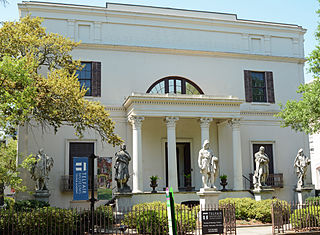
The Telfair Academy is a historic mansion at 121 Barnard Street in Savannah, Georgia. It was designed by William Jay and built in 1818, and is one of a small number of Jay's surviving works. It is one of three sites owned by Telfair Museums. Originally a family townhouse belonging to the Telfair family, it became a free art museum in 1886, and thus one of the first 10 art museums in America, and the oldest public art museum in the South. Its first director, elected in 1883, was artist Carl Ludwig Brandt, who spent winters in Savannah. It was declared a National Historic Landmark in 1976.

The Isaiah Davenport House is a historic home in Savannah, Georgia, United States, built in 1820. It has been operated as a historic house museum by the Historic Savannah Foundation since 1963.
Charles Elbert Fraser was an American real estate developer whose vision helped transform South Carolina's Hilton Head Island from a sparsely populated sea island into a world-class resort. He graduated from the University of Georgia and Yale Law School. Through his company, Sea Pines Company, he developed Sea Pines Plantation, Amelia Island Plantation, River Hills Plantation, and Kiawah Island Resort, among several other master planned communities. Fraser died in 2002 at the age of 73 in a tragic boat explosion in the Turks and Caicos Islands while on a consulting project.

Joseph Bacon Fraser commanded the 48th Armored Division of Georgia and Florida Army National Guard. His military career spanned from World War I to the Korean War before retiring a lieutenant general in 1956. He was also a former mayor of Hinesville, a timber baron, and one of the first resort developers of Hilton Head Island, South Carolina, which his son, Charles E. Fraser, developed into Sea Pines Plantation.
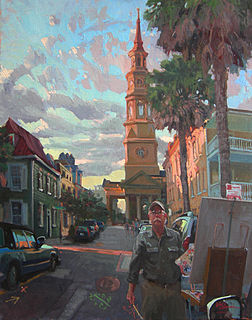
James West Fraser is an American artist. One of the leading artists in the representational/plein air tradition, Fraser has built his career on richly painted, atmospheric vistas of cities, coasts, and the landscape.

Beneventum Plantation House, originally known as Prospect Hill Plantation, is a historic plantation house located near Georgetown, Georgetown County, South Carolina. It was built about 1750, and is a two-story, five bay, Georgian style house. It features a one-story portico across the center two-thirds of the façade. The rear half of the house was added about 1800, with further rear additions made probably early-20th century. It was the home of Christopher Gadsden, a prominent statesmen and soldier of the American Revolution, the originator of the “Don’t Tread on Me” flag, and Federalist Party leader in the early national period.

The Flannery O'Connor Childhood Home is a historic house museum in Savannah, Georgia where American author Flannery O'Connor lived during her childhood. The home, built in 1856, is located at 207 E. Charlton Street in Lafayette Square.
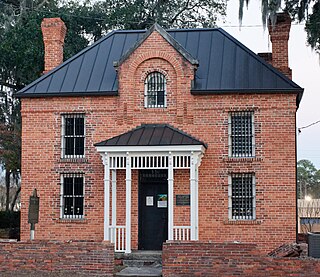
The Liberty County Jail is a historical building in Hinesville, Georgia, built in 1892. It was added to the National Register of Historic Places in 1992.

Clermont Huger Lee was a landscape architect from Savannah, Georgia, most known for her work designing gardens and parks for historical landmarks in the state. Specifically, Lee is known for her designs such as the Juliette Gordon Low Birthplace, Isaiah Davenport House and Owens-Thomas House. Lee assisted in founding of the Georgia State Board of Landscape Architects which serves as a licensing board for landscape architects throughout Georgia. She is considered one of the first women to establish their own private architecture practice in Georgia and was inducted into the Georgia Women of Achievement in 2017 and Savannah College of Art and Design's Savannah Women of Vision on February 14, 2020. SCAD honors Lee with a gold relief in its Arnold hall.

Jones/Derenne Range, also known as Jones' Lower Range, is a historic building located on East Bay Street in Savannah, Georgia, United States. Located in Savannah's Historic District, parts of the building date to 1817. The Savannah Historic District is listed on the National Register of Historic Places, and this building is a contributing property.

Madison Square is one of the 22 squares of Savannah, Georgia, United States. It is located in the fourth row of the city's five rows of squares, on Bull Street and Macon Street, and was laid out in 1837. It is south of Chippewa Square, west of Lafayette Square, north of Monterey Square and east of Pulaski Square. The square is named for James Madison, fourth president of the United States. The oldest building on the square is the Sorrel–Weed House, at 6 West Harris Street, which dates to 1840.




















